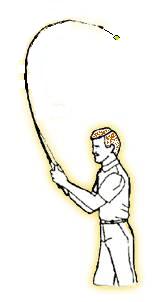How to Cast a Baitcast Reel

Baitcast reels can present some real challenges. While you are developing your casting technique expect to see plenty of "bird nests." That's what we call the backlash of tangled line caused by the spool moving faster than the line can be dragged off by the lure. Patience, timing and practice are the best tools of a new baitcast user.
Learning to baitcast requires some practice, but the effort will be well worth it once you've mastered the technique.
Step 1 - It is very important to set the spool pressure adjustment properly. The cast control allows you to maximize your cast without any backlashes. Place the reel on the rod, thread the line through the guides and attach a practice plug. Hold the rod at a 45 degree angle and press the spool release button or thumb bar. Make small adjustments until the plug slowly descends to the ground without any pressure from your thumb. Make sure the spool stops rotating immediately when the lure touches the ground. As you become better at casting, you can ease up on the tension to lengthen your cast.
Step 2 - With the plug about six inches from the tip of your rod, place your thumb on the spool. Depress the thumb button. This disengages the spool.
Step 3 - Choose your target. Bring the rod back to the 11:00 position, just behind your head.
Step 4 - In one quick, fluid motion, move the rod forward using your forearm and wrist to accelerate the tip of the rod. At the end of the motion, remove your thumb from the spool, allowing the speed and weight of the lure to pull the line off the reel. Thumbing the spool: While casting, your thumb should be placed on the spool, but barely touching it
Step 5 - Just as the bait touches the water at the end of a cast, you should apply pressure to the spool to stop it from spinning. Failure to do this will cause the line to backlash. As you become proficient at casting, you will rapidly learn how much thumb pressure is required for accurate casting.
Big Jim always called a backlash a professional over cast.
Bookmark this page on your mobile phone for future reference.